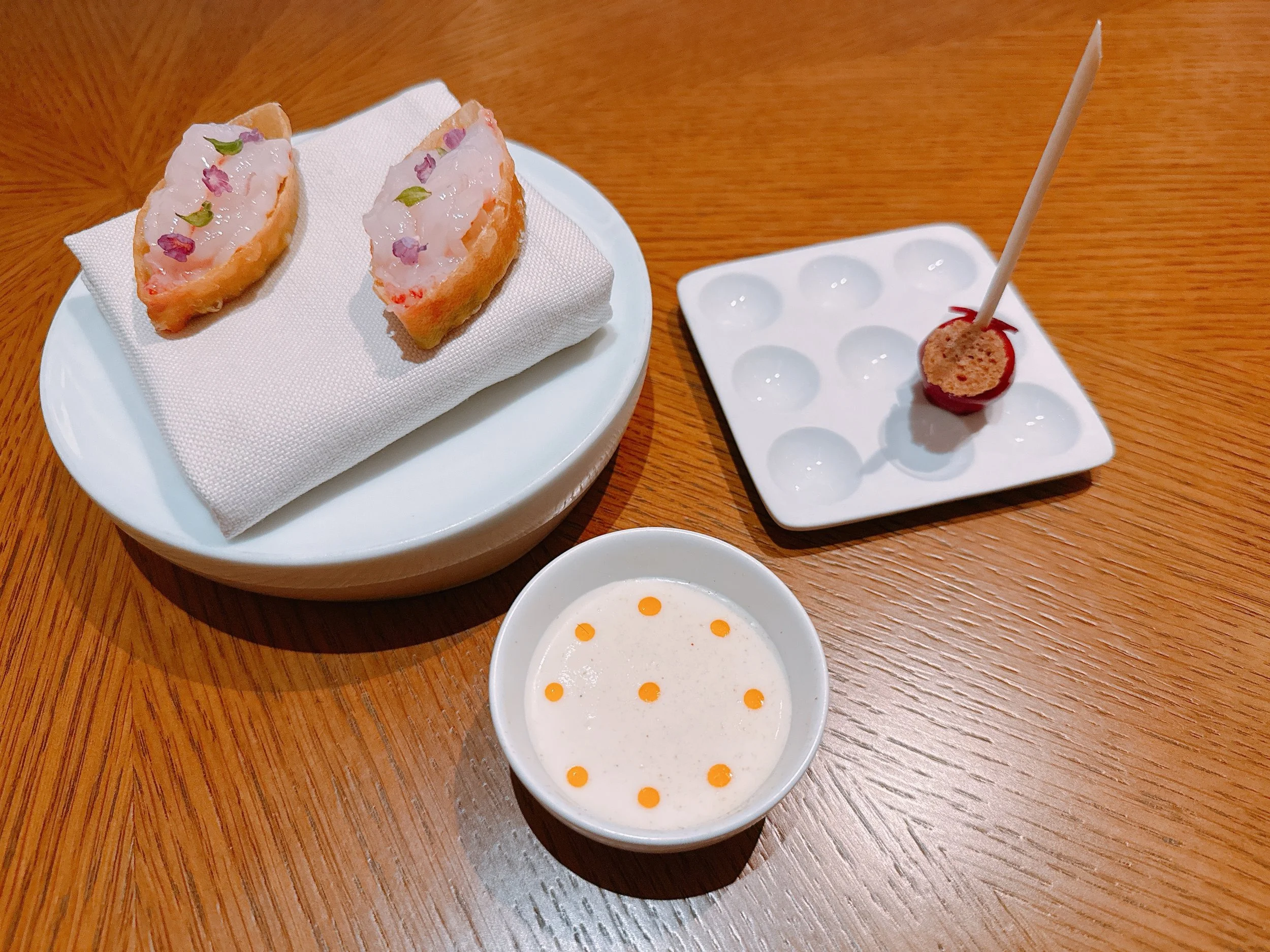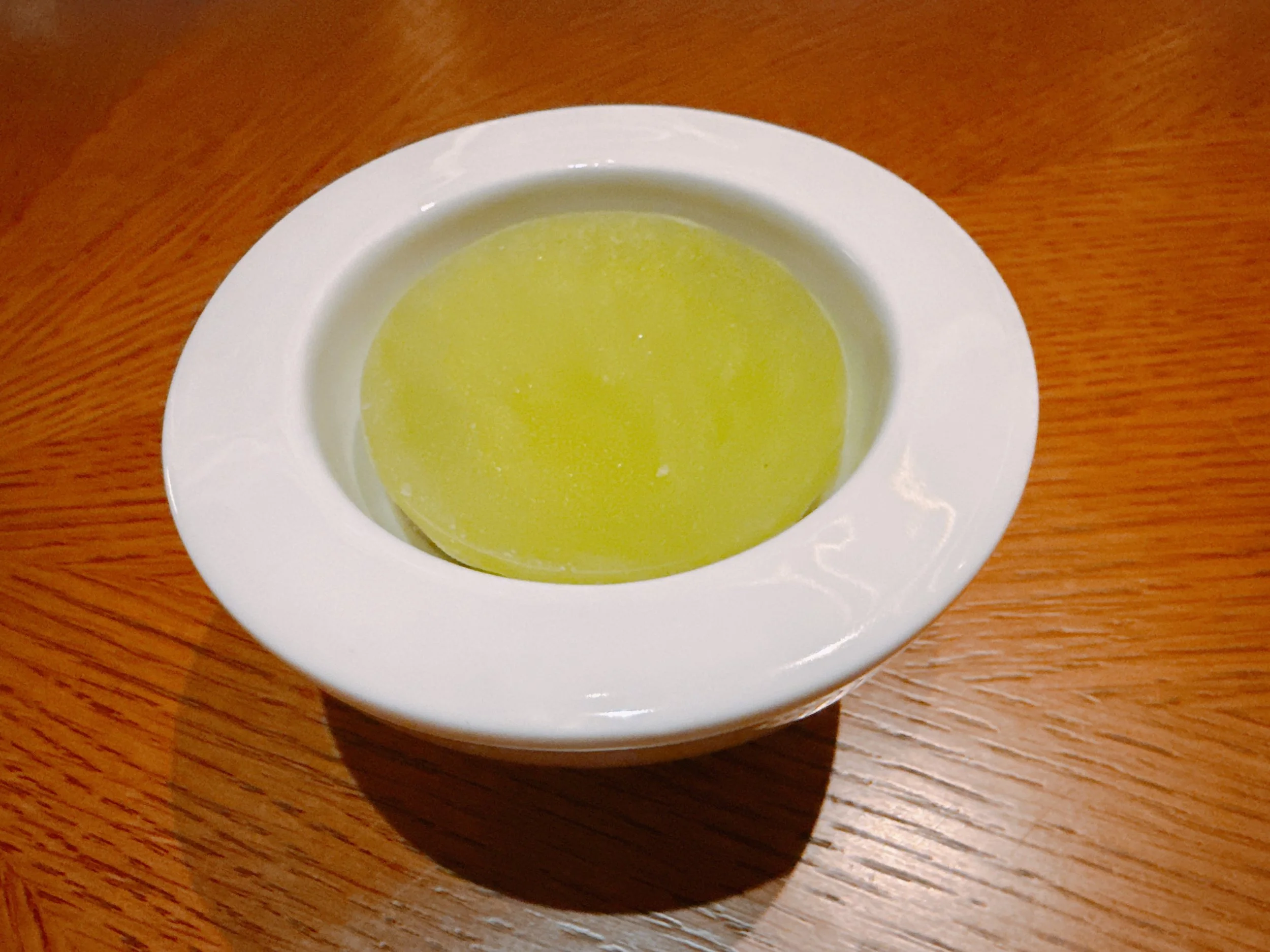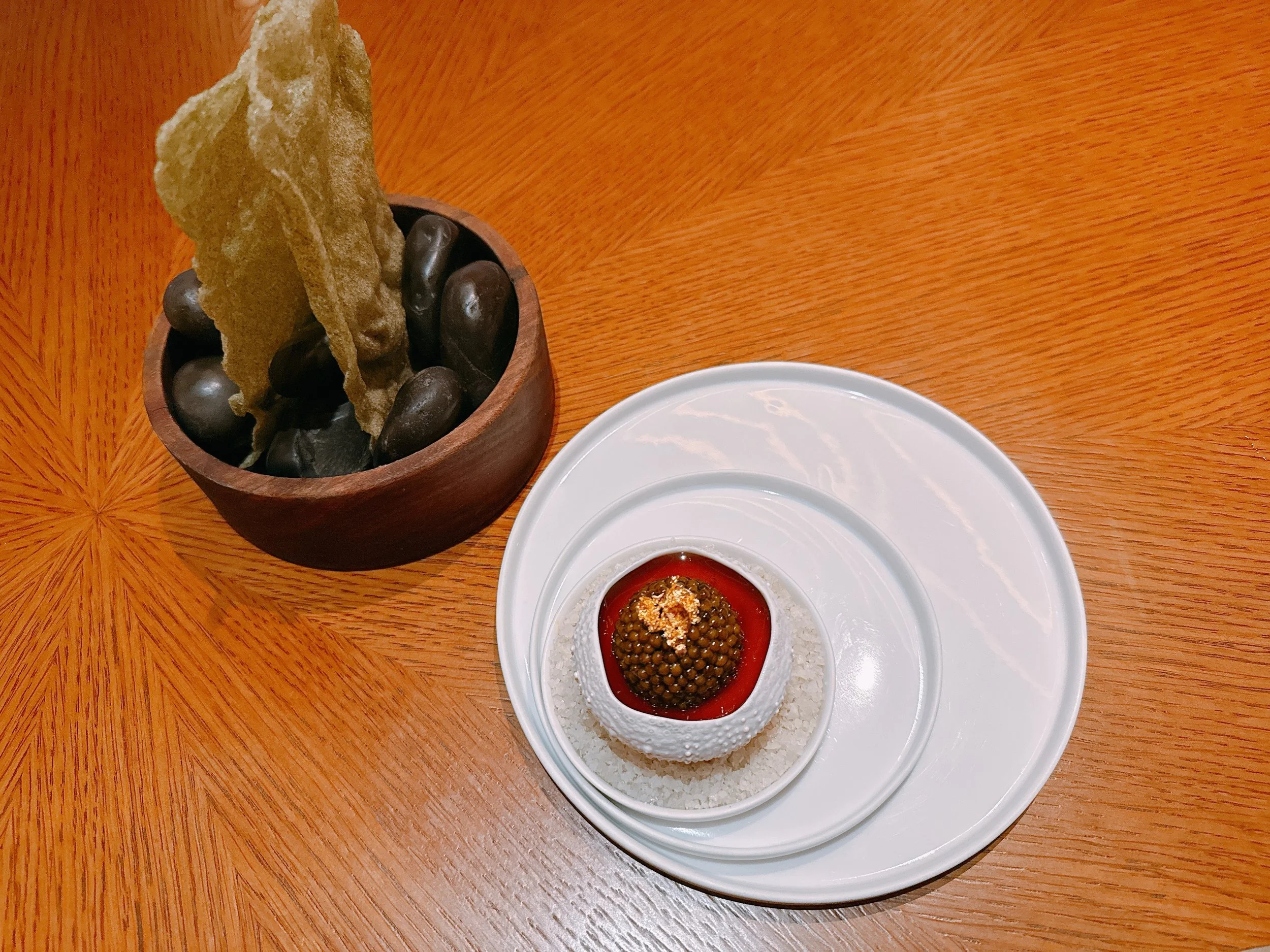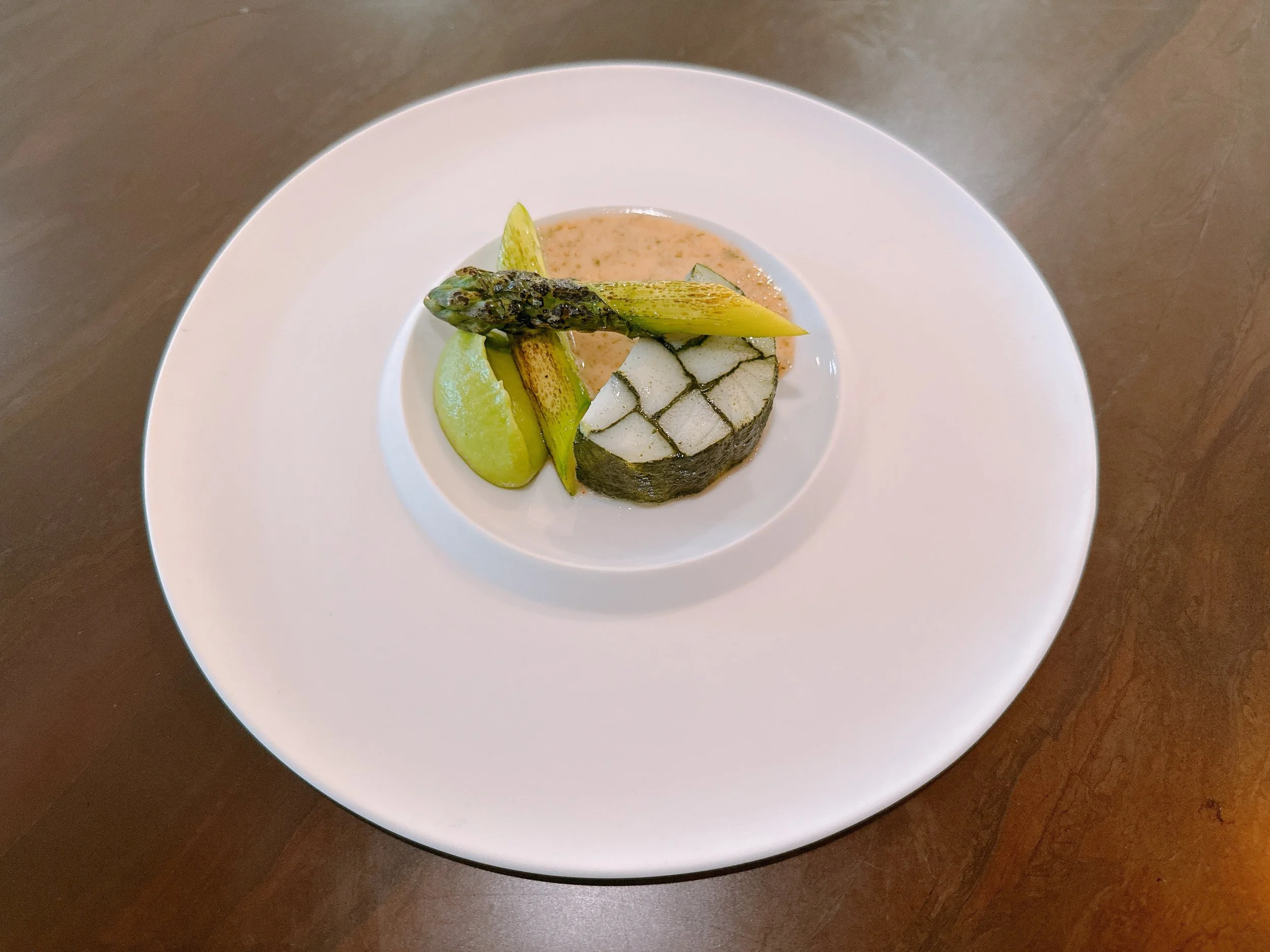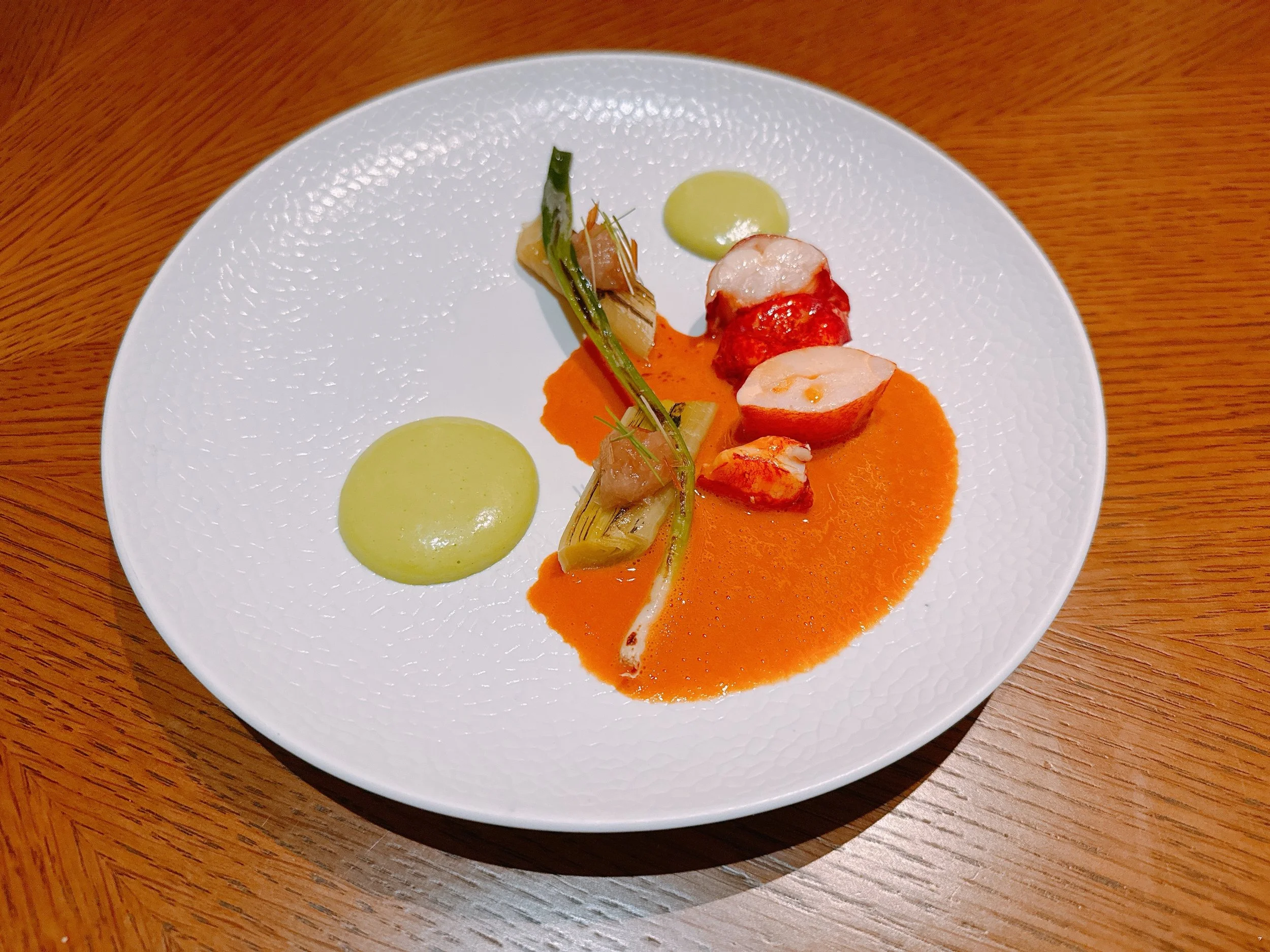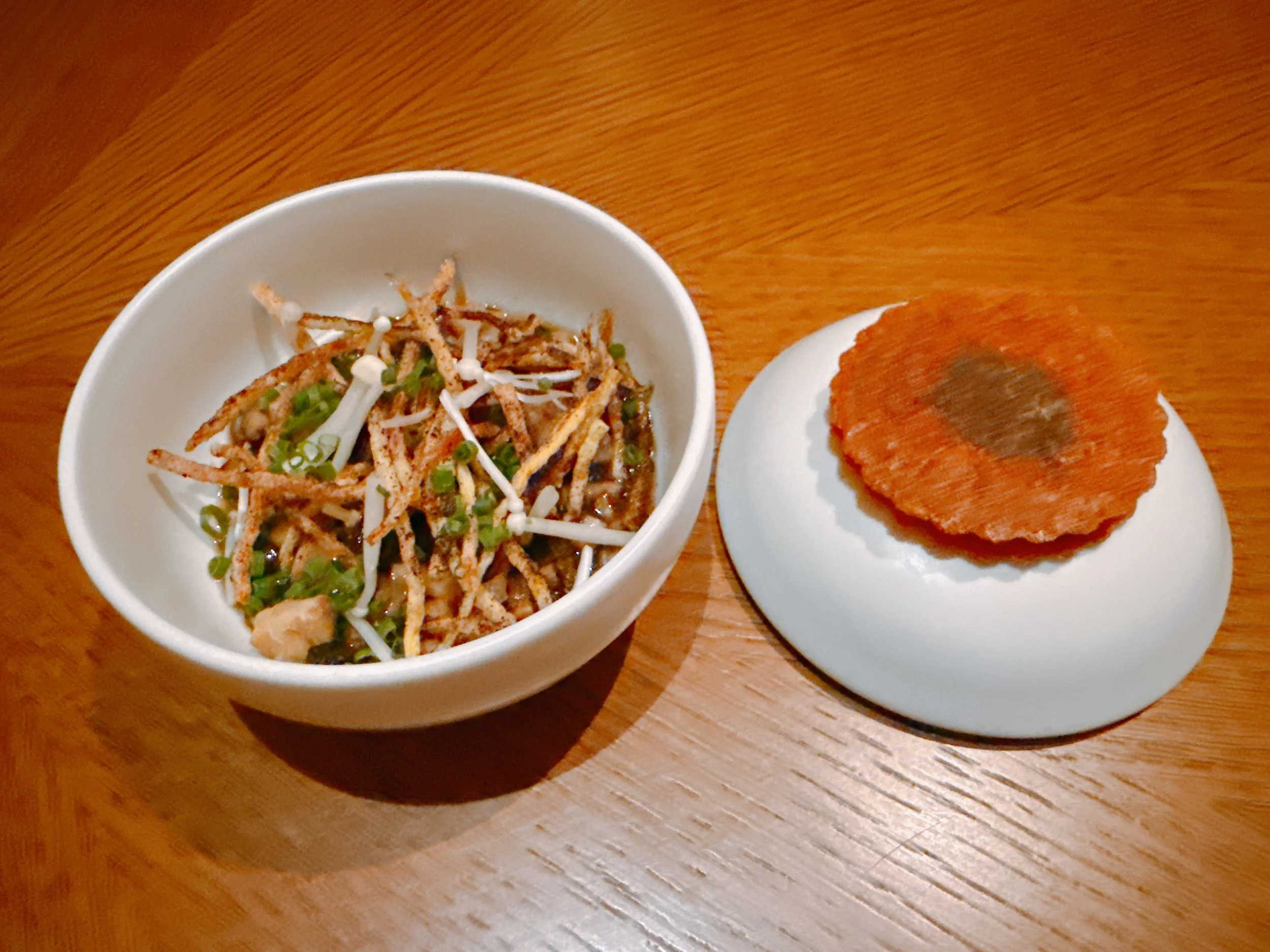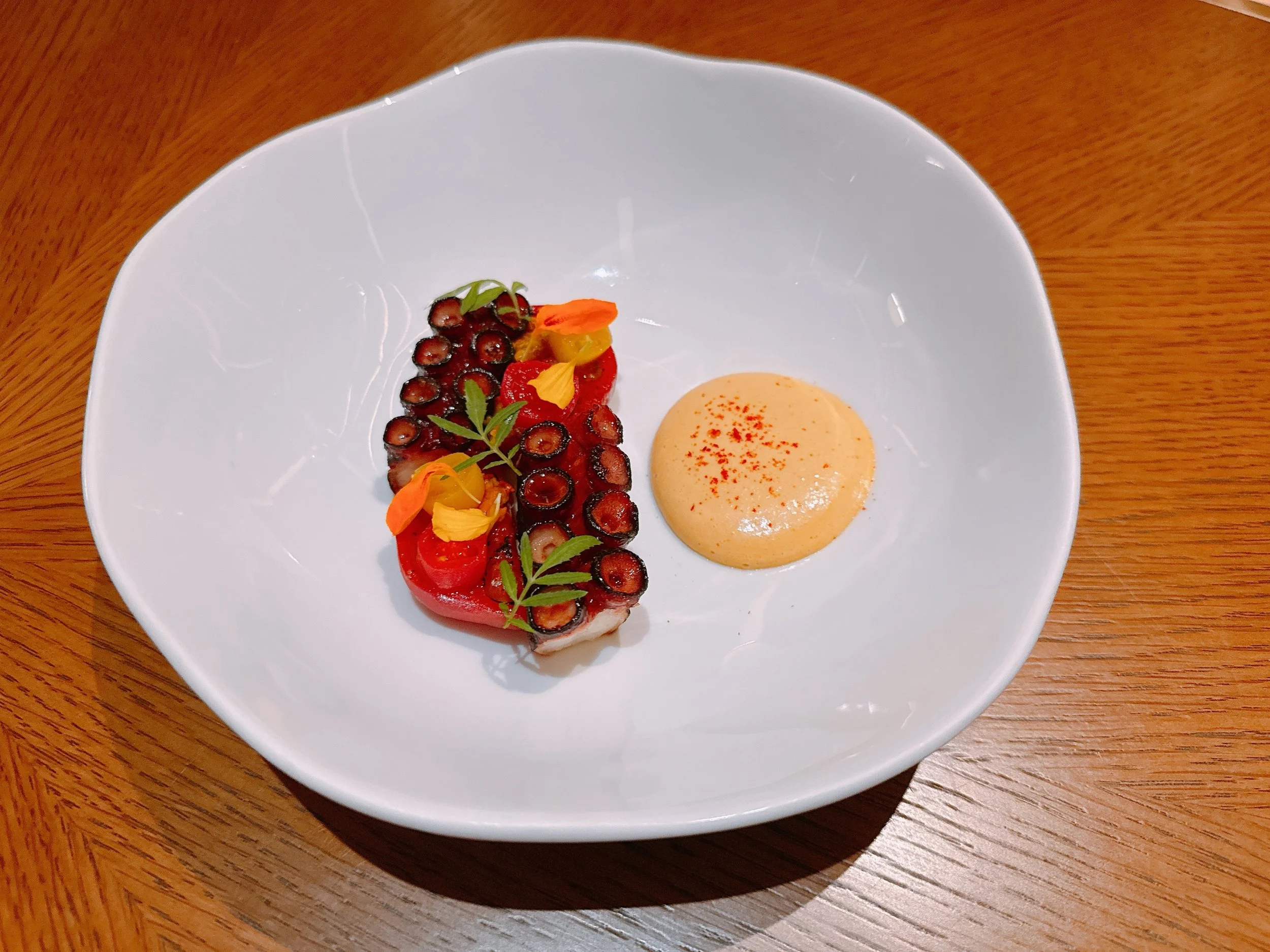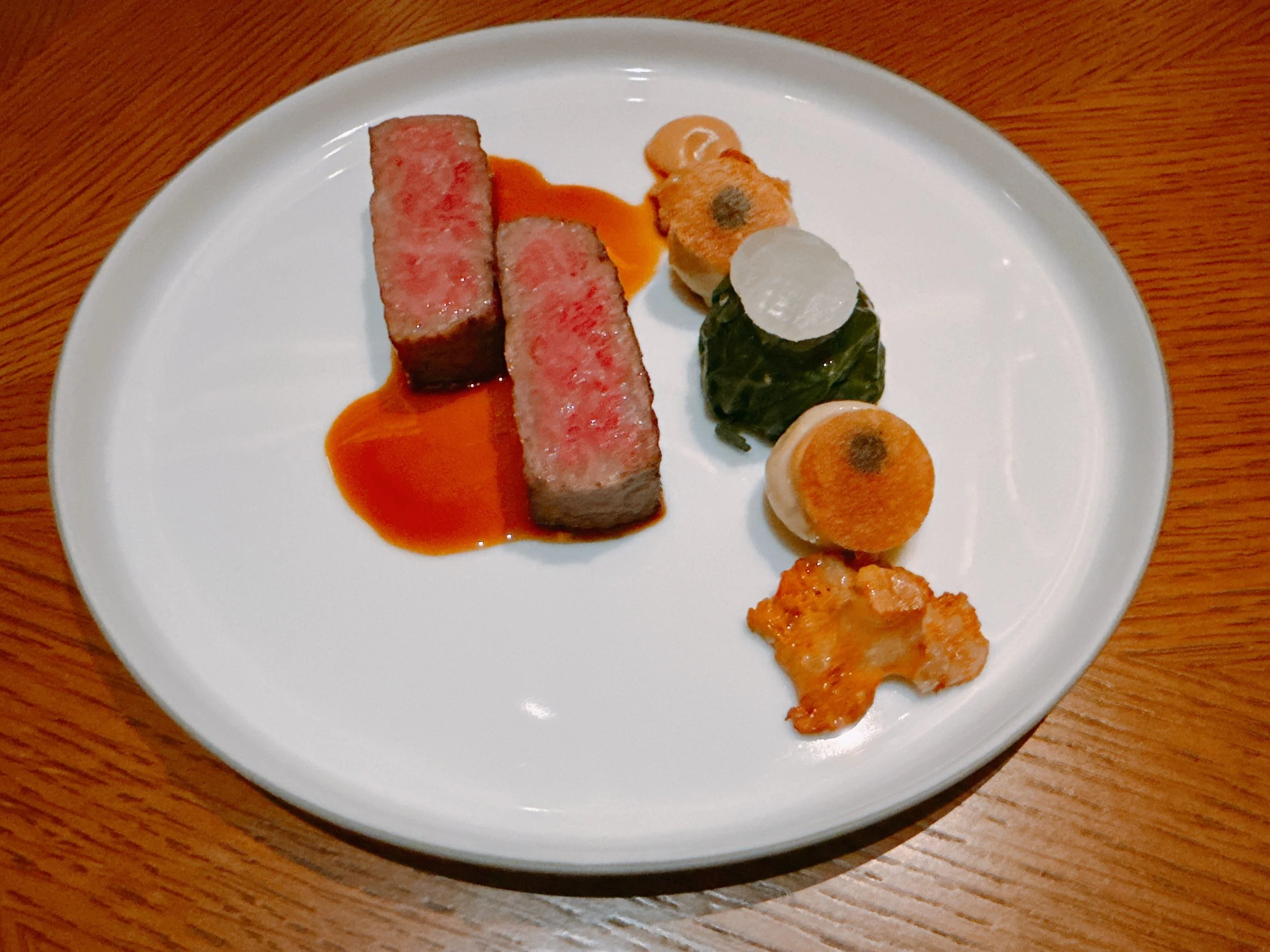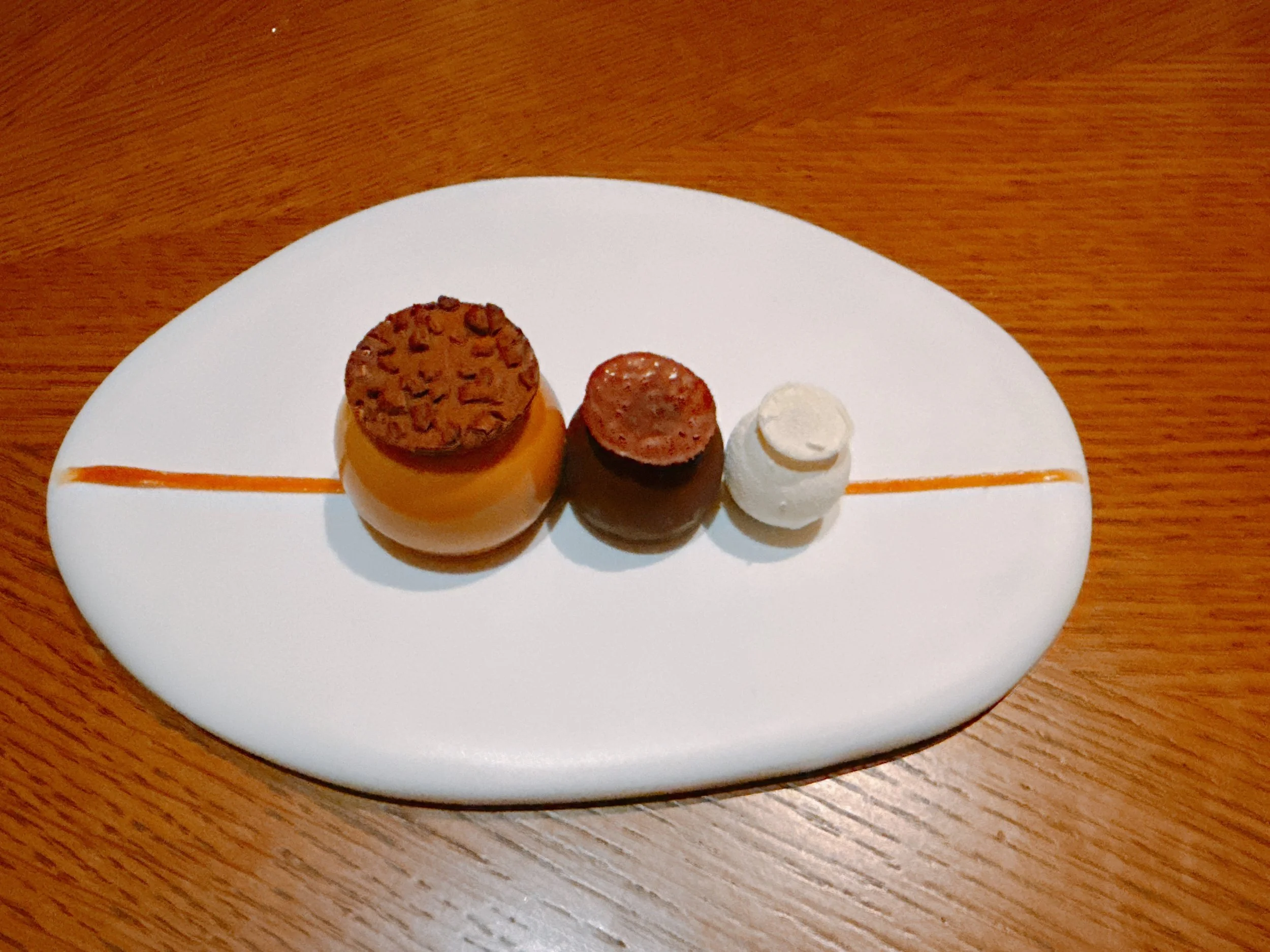Amber - Hong Kong
Rating: 16/20
Where: Hong Kong, Hong Kong
When: Dinner for 2 on 8 May 2025
Cost per Person: Tasting menu 2058-2888 HKD, Wine pairing 888-2888 HKD
Accolades: 3 Michelin Stars
Why: French cuisine without dairy and butter; a couple of exceptional dishes
After visiting Hong Kong for a week in February, we didn’t expect to be back so soon. But in mid-March, Michelin elevated “Amber” to three stars, a restaurant that consistently held two stars ever since Michelin started publishing its Hong Kong guide in 2009. The restaurant is located on the 7th floor of the Landmark Mandarin Oriental hotel, directly opposite another three-star restaurant - Sushi Shikon. At Amber, chef Richard Ekkebus and chef de cuisine Terry Ho deliver a French cuisine that at first glance looks very traditional. Apart from a few local ingredients, there is no real reference to the restaurant's location in Hong Kong. What turns out to be very unusual, though, is that this French restaurant doesn't use any dairy in its cooking, with the goal to make the food lighter and healthier. French cuisine without butter - incroyable? Instead, the chefs rely on nuts and fermentation, but the changes in the resulting dishes are surprisingly pretty minor - if we hadn't been told, we might not even have suspected the absence of dairy, which is quite an accomplishment in and of itself.
Entering the hotel that houses Amber was a bit anti-climatic, since it was closed for renovations during our visit. In fact, the only parts that seemed to be open were its two three-star restaurants and the bar in-between the two. But that was quickly forgotten after we entered the restaurant’s modern, yet elegant dining room. The long room was flanked by windows looking out on skyscrapers in Hong Kong's Central district. Unfortunately, these were mostly generic office buildings, so that the view didn't quite compare to the one we had at, say, Caprice. That might explain why the sheer curtains were closed for the duration of our dinner. In any case, the restaurant definitely had an urban feel.
For a tasting-menu-only restaurant, Amber offered an astonishing number of dishes. First, there were three different tasting menus with barely any overlap: six courses for 2058 HKD, eight courses for 2888 HKD, and matching vegetarian menus for the same prices. In addition, the non-vegetarian menus had two different dish choices for several courses. One would have to dine here at least three times to sample everything that was on offer. And if that wasn't enough, there was also the option to add an additional secret course, called the “Amber Enigma”, for 458 HKD including a class of Ruinart champagne. We went for the eight course menu and added an single Enigma dish to share.
Settling on a menu was only half the work, though. The choices among the wine pairings were even more abundant: there were a total of five of them, all but one consisting of five glasses. In increasing price order, they were: a pairing consisting solely of wines from China and Japan for 888 HKD, a three-glass French grand cru pairing (Champagne, Burgundy and Bordeaux) for 1188 HKD, a Burgundy-only pairing for 1288 HKD, the restaurant's “signature” pairing for 2288 HKD and a Dom Perignon-only pairing for 2888 HKD. None of the pairings included dessert wines, which could be added from the restaurant's extensive by-the-glass list that contained no fewer than 39 wines, not even counting fortified wines and sakes. I went for the 2288 HKD signature pairing, and the wines were all very good, in some cases exceptionally so (a 2013 Dom Perignon and a 2017 Austrian Shiraz in particular). All paired wines would have cost at least $100 per bottle in a retail store, a few of them were closer to $300. In that sense, the not insubstantial cost of the pairing seemed to be pretty fair.
Our dinner started with three small amuse bouches. A white asparagus soup had been decorated with orange dots of ebi (shrimp) oil. This was a very focused dish, in the sense that the lovely asparagus flavor was extremely strong, and one couldn't really taste the shrimp at all 18. Our next bite was a canoe-shaped cracker filled with ebi, pickled asparagus and edible flowers. The shrimp was creamy and of good quality, and the cracker and (to a lesser extent) the asparagus added some crunch to the dish. It was fun to see that these first two dishes used the same two ingredients (asparagus and shrimp), but each dish focused on a different ingredient, leading to totally different flavor impressions. A nice touch, especially since amuse bouches often have barely anything to do with each other 17. Lastly, we tried a foie gras lollipop. Clearly, this one didn't follow the shrimp/asparagus theme. That was because it was a complimentary dish served to members of Mandarin Oriental's loyalty program - apparently my reservation email had been matched automatically. Unfortunately though, this was the weakest among the three bites. The foie gras was fine and thankfully not sweet, but otherwise the dish was fairly unremarkable 16. The pescatarian replacement was a beet lollipop: literally just a piece of cooked red beet on a stick without any seasoning. The beet was decent enough, but still... 14.
The first official course of our tasting menu was an oyster, served with a tomatillo salsa under a disc of green apple ice that was seasoned with jalapeños. The green ice was indeed lightly spicy, but it also watered down the flavors in the rest of the dish. The pre-cut pieces of oysters were a mixed bag - they were fine for the most part, but each of our dishes contained one piece of oyster than was so chewy that it was essentially impossible to eat. We were puzzled how an oyster could have such a tough texture, maybe it was the adductor muscle? Even ignoring that for the rating, though, flavorwise, this dish was still a big step down from the appetizers 15.
Lack of flavors was definitely no concern for the following dish, a signature of the restaurant. A cauliflower mousse was topped with an aka uni (sea urchin) from Hokkaido, a lobster jelly and a generous helping of caviar. On the side was a seaweed cracker, available to scoop up the mousse. The main two flavors in this dish came from the intense, very creamy cauliflower mousse, and from the lovely caviar. The other ingredients were mostly there to round out the dish - the uni added a bit of creaminess, but was light in flavor, and the lobster jelly contributed a touch of seafood flavor. The seaweed cracker was a bit too oily for my taste, but my wife loved it. And while I'm nitpicking: the cauliflower cream felt a bit heavy. But overall, it's no wonder that this dish has stayed on the menu since the restaurant's opening 18.
At this point, we were served the “Enigma” course, but only after being told to put away our cell phones. No pictures, please, so that the dish can remain a surprise for new diners. Following the restaurant's wishes, I won't describe the dish in detail, except for mentioning that it is a seafood dish - that much was already revealed in the menu. Unfortunately, the seafood in question had an unexpectedly mealy texture - I wasn't blown away its quality. On the positive side, though, the accompanying lightly spicy sauce was full of flavor and very lovely 16.
Ordering the eight-course menu came with an added bonus: a trip to the restaurant's kitchen. Here, standing at a counter while watching the chefs in action, we were served our next course. It arrived with a sparkling white peony tea that was maybe meant as a palate cleanser? Not exactly my thing, unfortunately, and I didn't finish the glass. The food was much better, thankfully. Japanese mackerel was served in a mosaic presentation, separated by marinated kombu and topped with seaweed powder. Fresh green asparagus was added both in grilled form and as a puree. The final component of the dish was a beurre blanc with some cod roe. But the sauce was made without actual butter, and used a cashew nut butter instead. The fish was cooked very nicely with a good texture, and the sauce was lightly nutty. Not really something one would mistake for a beurre blanc, but very good on its own terms. The asparagus had a strong vegetable flavor. I liked that this dish delivered big flavors without being particularly salty 18.
Back at our table, we were served a warm loaf of sourdough bread, accompanied by another nut butter, this one containing cashews and coconut. The bread was crunchy with a nice sourdough flavor, and the salty butter worked better than expected, but admittedly I would have preferred a “real” butter here 16.
Soon thereafter, it was time for a blue lobster course, incorporating the prized crustacean as a confit, grilled and in a lobster bisque. Charred leeks, pickled shallots, green onions and a shiso mousse completed the dish. The lobster was merely ok - it didn't have much flavor and was somewhat chewy. The best part of the dish were the vegetables: crunchy green onions, nice leeks, all going wonderfully with the foamy, herbal shiso sauce. I wish that we had been given a spoon for the sauces, but the bread was a gladly employed second-best option 17.
The following dish featured foie gras, but in an unusual preparation: as part of an egg custard. It was served with a Japanese mushroom tea and topped with fried julienned potatoes, enoki mushrooms and chives. On a separate plate, we received a feuille de brick sandwich filled with a fermented black onion sauce and sliced mushrooms. The egg custard indeed tasted mostly of eggs - I wouldn't have guessed that it contained any foie gras. Other than that, the main flavor of this dish came from the mushrooms: an earthy, savory taste with a little crunch added by the potatoes. The cracker was even more crunchy and its filling had a mushroom taste and lots of umami 15. The pescatarian replacement for this dish came from the six-course menu. Charcoal-grilled Japanese octopus was served with tomatoes and a sabayon seasoned with marigolds and espelette chili powder. That sabayon was quite nice - it had good flavors, going well with the lightly smoky octopus. Oddly though, the tomatoes were served cold in an otherwise warm dish 16.
For the main savory course, there was a choice between a lamb and a beef dish. I went for the latter, which came with a 500 HKD surcharge.
Charcoal-grilled Japanese A4 wagyu was served with several different preparations of mushrooms: a mushroom puree, glazed griolle mushrooms and button mushrooms. Finally, there was some Swiss chard filled with braised oxtail and celtuce, and a wagyu jus sauce. Sadly, this dish was not served very warm, and the beef was chewier and fattier than I would have liked. This was a pretty heavy dish at the end of a substantial meal, and to my chagrin, I wasn't able to finish it; for me, a half portion might have been ideal. The oxtail had some nice seasoning, and there was an oddly sweet pickle on top of the Swiss chard. The button mushroom tasted marinated, comparable to the kind one might buy in a glass jar 15. Since my generally-pescatarian wife also eats chicken, she received a poultry dish from the six-course menu. A local “Ping Yuen” chicken was served with a chicken mousse flavored with tarragon, a chicken jus and a romaine lettuce leaf. On the side were a sweet pea puree, some green peas, and a morel mushroom filled with chicken sausage. The chicken meat itself was lightly juicy and quite good, but the mousse had an oddly mealy texture. As for the sides: the peas were crunchy, and the herbal cream was nice, but sadly not particularly warm. Even odder, the crisp romaine lettuce leaf was literally served cold 15.
The first of two desserts was a crispy tartlet filled with a pineapple carpaccio, a mango curry mousse, white coconuts and topped with a black kumquat sugar disc. On the side was a black kumquat sorbet. Said sorbet was a bit weird - lemony, but having a slightly bitter aftertaste. I liked the crunchy cookie, but the rest of the components, while fine by themselves, didn't really add up to anything more than their sum 14.
Dessert number two was very heavy on chocolate, a 75% dark chocolate from Vietnam, to be precise. There were three preparations. From right to left in the picture: a soy ice cream with cocoa, a chocolate mousse, and a brazil nut ganache with a coconut filling. This was quite a heavy dessert - apparently the lack of butter doesn’t guarantee a light dinner. The soy ice cream was fine, but its fatty shell felt too thick. The mousse was very heavy, to the point of being almost inedible. And the brazil nut ganache was very nutty, but also pretty fatty (no wonder given that brazil nuts are among the fattiest of nuts). I would have preferred something lighter at this point 14.
Our dinner concluded with some petit fours. Our server spent some time explaining what the term “petit fours” meant. That lesson would probably be unnecessary for guests accustomed to fine-dining restaurants. But maybe it suggests something about Amber's average clientele? Maybe they are more likely to be people who are simply here to celebrate a special occasion?
Anyway, first we tried a gluten-free madeleine made with sesame and Japanese red miso. Its texture was mealy, and had a distinct sesame taste - interesting. Out server mentioned that it was served warm on purpose. Unfortunately, it wasn't warm anymore by the time we ate it - after the introduction of all the dishes and my inevitable photo shoot. Dang. Next time, I'll take a picture of a half-eaten madeleine instead 14. A little praline made from pistachios, dark chocolate and a cherry was accompanied by a small “M.O.” disc - a second small gift for members of Mandarin Oriental's loyalty program. The best part of this dish was the fruity cherry, but the rest was pretty fatty and heavy 13. Finally, a selection of three fresh fruit: papaya, milk fruit and Japanese loquat. None of these were particularly sweet. The papaya (the sweetest one among the three) had a bit of seasoning 13. All of this was paired with a beverage that was inspired by Japanese plum wine, but made from yuzu, brown crystal sugar and rice wine. It had a light yuzu flavor and was not too sweet 14.
Overall: This was a dinner that definitely nailed the interior design and the culinary presentations appropriate for a three-Michelin-star restaurant: these were easily the prettiest dishes among several recent three-stars that I've been to. The service was generally good as well, but our server's insistence on explaining standard fine-dining terms like “petit fours” were a bit unusual. Foodwise, this was a curious dinner. There were a few amazing dishes that clearly fit Michelin's three-star judgment. But there were also a number that fell way short, coming in at a one-star level or even below. And barely anything between these two extremes. If the menu had been shortened to just the best dishes, I'd have no concerns with Michelin's assessment. But I'm not so sure given the other courses 16.

